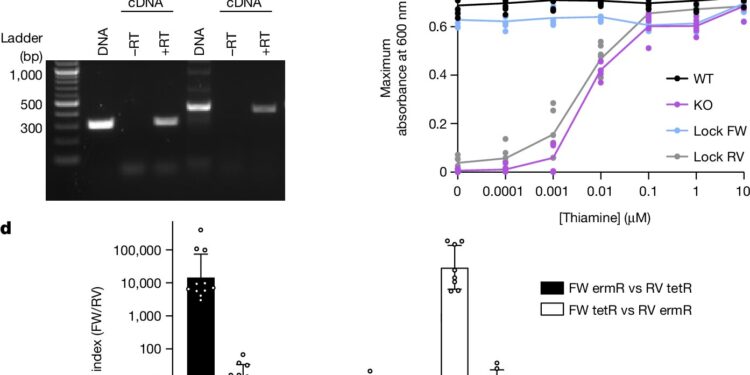Consequences of inversion in thiamine protein biosynthesis. Credit: Nature (2024). DOI: 10.1038/s41586-024-07970-4
Imagine you’re about to change your appearance. One move and your brown hair turns platinum blonde. It’s not far from what happens in some prokaryotes, or single-celled organisms, like bacteria, which undergo what are called inversions.
A study by Stanford Medicine scientists has shown that inversions, which physically flip a segment of DNA and change an organism’s genetic identity, can occur within a single gene, challenging a central dogma of biology: A gene can code for only one protein.
“Bacteria are even cooler than I originally thought, and I’m a microbiologist, so I already thought they were pretty cool,” said Rachael Chanin, Ph.D., a postdoctoral researcher in hematology. Microbiologists have known for decades that bacteria can flip small sections of their DNA to turn genes on or off, Chanin said. To the team’s knowledge, however, these bits of somersault have never been found within the confines of a single gene.
In the same way that reversing the order of the letters in the word “dog” can completely change the meaning of a sentence (“I am a dog” versus “I am a god”), intragenic inversion is essentially recoding the bacteria’s genetics using the same material. This can result in a gene being turned on, a gene being turned off, or a sequence that codes for a different protein when reversed.
“I remember seeing the data and thinking, ‘This can’t be true, this is too crazy to be true,’” said Ami Bhatt, a professor of genetics and medicine. “We then spent the next few years trying to convince ourselves that we had made a mistake. But as far as we know, we hadn’t.”
A study detailing the scientists’ findings was published Sept. 25 in NatureChanin and former postdoctoral researcher Patrick West, Ph.D., co-led the study. Bhatt is the lead author.
About-face
In the 1920s, scientists first discovered signs of inversion while searching for a treatment for salmonella. They tried to collect antibodies from animals infected with the bacteria in the hopes that the immune molecules could be transferred to other animals and avoid infection. But it never worked: Even strains of bacteria they knew were genetically identical were able to fight back. Scientists now know that the escape happened because of an inversion that recoded the bacteria in a way that allowed it to evade the animals’ immunity.
Since then, microbiologists have discovered inversions in small segments of DNA in various types of prokaryotes. But Bhatt and his team wondered whether they could also occur within a single gene. West created an algorithm, called PhaVa, that identifies possible inversions within bacterial genomes.
The software essentially downloads thousands of segments of genome sequences from various prokaryotes and looks for regions that appear to be “reversible” (segments containing so-called inverted repeats, which have a redundant palindromic quality (e.g., ATTCC and CCTTA)) on the other side of the potential inversion.
The algorithm creates a catalog of what these sequences would look like if they were reversed, and it makes comparisons between the invented genomes and the real sequence. It then counts the regions where the reversed and non-reversed sequences are present in an organism’s genome, with each match indicating a likely inversion.
The software identified thousands of inversions that exist in bacteria and other prokaryotic species, revealing for the first time that inversions occur within genes. This sparked the idea that not only do single-gene inversions occur, but they may be relatively common, Bhatt said.
“It really surprised us,” Bhatt said. “To our knowledge, this has never happened before.”
A big question remains: what causes an inversion? The team suspects that specific enzymes are involved in this reversal, as well as certain environmental signals that trigger this change.
“That’s a task that needs to be done now,” Bhatt said. “One of our next steps is to try to decode the molecular grammar so that we can create a database of enzymes and a database of the inverted repeats that they invert.”
Interpretation of inversions
While there is still much to understand about inversions, Bhatt sees potential for many applications. “It’s actually a type of heritable, reversible genetic regulation,” she said.
She speculates that scientists could one day use inversions to create a switchable bacterial system that could control the expression of their genes, which could be a field of synthetic biology research. Or perhaps there are links between certain diseases and the state of bacterial inversions, in which case there might be a way to change the state of bacteria and regulate a disease.
“This kind of adaptation is hiding right in front of our eyes, waiting for the right tool, the right technology and the right biological question to be asked,” Chanin said. “And it makes me wonder how many other bacterial secrets are just waiting for us to discover them?”
Researchers from Princeton University contributed to this study.
More information:
Ami Bhatt, Intragenic DNA inversions increase the coding capacity of bacteria, Nature (2024). DOI: 10.1038/s41586-024-07970-4. www.nature.com/articles/s41586-024-07970-4
Provided by Stanford University Medical Center
Quote:Bacterial ‘flipping’ allows genes to take different shapes (2024, September 25) retrieved September 25, 2024 from
This document is subject to copyright. Apart from any fair dealing for the purpose of private study or research, no part may be reproduced without written permission. The content is provided for informational purposes only.



